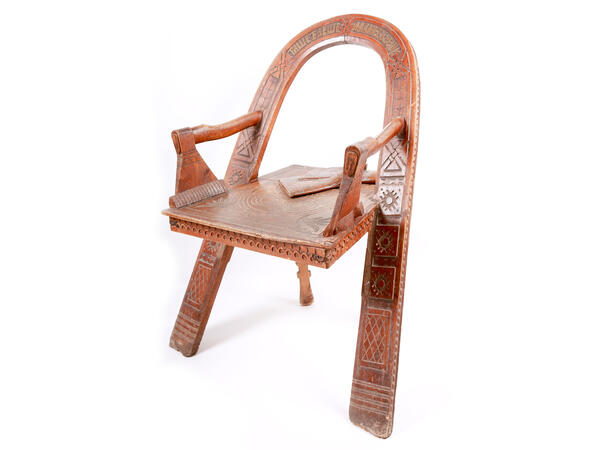The collection of the Kasimov Historical and Cultural Museum-Reserve contains the armchair “Shaft bow, axe and gloves” created by Vasily Shutov.
The armchair has a number of attributes of peasant life: the back is bow-shaped, which is an element of horse harness, arm pads are in the form of axes, and gloves are depicted on the seat. The furniture item is decorated with carvings: the craftsman carved the inscription on the bow: “Make haste slowly” — a saying of Russian coachmen, and geometric and solar patterns on the legs.
The craftsman Vasily Shutov was born in a wealthy family, but soon his parents went bankrupt. Young Vasily Shutov was sent to the St. Petersburg carpentry. As teachers said, the boy was rather talented. He attended the stock drawing school for 8 years and then founded his own carpentry.
In 1870, his carpentry presented their own works on All-Russian Exhibition in St. Petersburg, including his unusual armchair “Shaft bow, axe and gloves”. It immediately became popular: the visitors bought around 50 copies of the chair. At the exhibition, Shutov’s works received a bronze medal.
Despite the fact that the armchair was created in the late 19th century, it greatly differed from the furniture, which was popular at that time. The armchair design from the museum collection was called ‘exclusively Russian’ and its author became famous throughout the Russian Empire.
Vasily Shutov received the permission from the Department of Trade and Manufacture to produce the armchair ‘Shat bow, axe and gloves’ for 10 years — at that time such a document was considered to be a patent. Copies of the armchair, made by other carvers, began to appear in the Russian Empire when the permission was expired.
The furniture item was copied until the early 20th century. Some craftsmen used to add new details to their armchairs: whip, bast shoes, drills and balalaika. They sometimes changed the form of the seat or the text of the saying, carved on the bow.
The armchair could often be met in apartments and mansions of the Russian intelligentsia. They also say the Shutov’s armchair stood in the study of the Emperor Alexander III.
The armchair has a number of attributes of peasant life: the back is bow-shaped, which is an element of horse harness, arm pads are in the form of axes, and gloves are depicted on the seat. The furniture item is decorated with carvings: the craftsman carved the inscription on the bow: “Make haste slowly” — a saying of Russian coachmen, and geometric and solar patterns on the legs.
The craftsman Vasily Shutov was born in a wealthy family, but soon his parents went bankrupt. Young Vasily Shutov was sent to the St. Petersburg carpentry. As teachers said, the boy was rather talented. He attended the stock drawing school for 8 years and then founded his own carpentry.
In 1870, his carpentry presented their own works on All-Russian Exhibition in St. Petersburg, including his unusual armchair “Shaft bow, axe and gloves”. It immediately became popular: the visitors bought around 50 copies of the chair. At the exhibition, Shutov’s works received a bronze medal.
Despite the fact that the armchair was created in the late 19th century, it greatly differed from the furniture, which was popular at that time. The armchair design from the museum collection was called ‘exclusively Russian’ and its author became famous throughout the Russian Empire.
Vasily Shutov received the permission from the Department of Trade and Manufacture to produce the armchair ‘Shat bow, axe and gloves’ for 10 years — at that time such a document was considered to be a patent. Copies of the armchair, made by other carvers, began to appear in the Russian Empire when the permission was expired.
The furniture item was copied until the early 20th century. Some craftsmen used to add new details to their armchairs: whip, bast shoes, drills and balalaika. They sometimes changed the form of the seat or the text of the saying, carved on the bow.
The armchair could often be met in apartments and mansions of the Russian intelligentsia. They also say the Shutov’s armchair stood in the study of the Emperor Alexander III.




